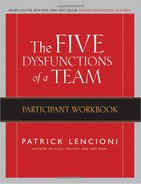FUNDAMENTAL #2: Mastering Conflict
Trust is important for a very practical reason: without it, teams cannot, and probably should not, engage in productive, ideological conflict.
CONFLICT ASSESSMENT ITEMS
- 2. Team members are passionate and unguarded in their discussion of issues.
- 4. Team meetings are interesting and compelling (not boring).
- 5. During team meetings, the most important—and difficult—issues are discussed.
- 7. Team members voice their opinions even at the risk of causing disagreement.
- 12. During discussions, team members challenge one another about how they arrived at their conclusions and opinions.
- 18. Team members solicit one another's opinions during meetings.
- 23. Team members communicate unpopular opinions to the group.
- 27. When conflict occurs, the team confronts and deals with the issue before moving to another subject.
NOTES

CONFLICT PROFILING EXERCISE
Answer these questions. Then share your answers with your team.
- What do you see in your behavioral profile that might affect your perception of and ability to engage in conflict?

- What was the conflict environment in your home while you were growing up? Were there spirited conversations, or did your family avoid difficult conversations?

- In what geographic area were you raised? What conflict style was accepted and expected?

- What professional experiences have influenced your ability to engage in unfiltered debate?

Use the spaces below to summarize the discussion about your team's experiences with conflict.
- What did you learn about your team members' experiences with conflict that you did not know?

- What are the implications of your team members' different experiences on this team's ability to engage in conflict?

CONFLICT NORMING EXERCISE
Write down your preferences relating to acceptable and unacceptable behaviors around productive, ideological conflict. Include the following:
- The kind of language and tone of voice people should use

- The emotional content of people's messages

- The extent of people's involvement and participation

- Other

Discuss with the team:
- What do our collective preferences seem to be in relationship to conflict?

- What significant differences do we have about conflict?

Our team's conflict commitments:
- What are our top four or five behavioral expectations around conflict?

CONFLICT RESOLUTION MODEL
NOTES ON THE CONFLICT RESOLUTION MODEL
CONFLICT RESOLUTION EXERCISE
![]()
List the obstacles that have been present during discussions about this issue:

Discuss with the team the impact of the obstacles on the team's decision-making process and ways in which the team can handle the obstacles in the future.
- Ways in which the obstacles impacted our decision-making process.

- What we can do to handle those obstacles so we can improve the way we engage in conflict and make decisions, both for this issue and for others?

KEY POINTS—MASTERING CONFLICT
- Good conflict among team members requires trust, which is all about engaging in unfiltered, passionate debate around issues.
- Even among the best teams, conflict will at times be uncomfortable.
- Conflict norms, though they will vary from team to team, must be discussed and made clear among the team members.
- The fear of occasional personal conflict should not deter a team from having regular, productive debate.
NOTES ON MASTERING CONFLICT

We are talking about productive, ideological conflict: passionate, unfiltered debate around issues of importance to the team. Any team that wants to maximize its effectiveness needs to learn to do this, and doing so can only happen if vulnerability-based trust exists.
If team members are not making one another uncomfortable at times, if they're never pushing one another outside of their emotional comfort zones during discussions, then it is extremely likely that they're not making the best decisions for the organization.
Ask yourself, “Are team members holding back?”


